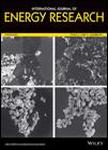版权所有:内蒙古大学图书馆 技术提供:维普资讯• 智图
内蒙古自治区呼和浩特市赛罕区大学西街235号 邮编: 010021

作者机构:Univ Pontificia Bolivariana Grp Invest Ingn Aeroespacial Campus Laureles Circular 1 70-01 Medellin Colombia
出 版 物:《INTERNATIONAL JOURNAL OF ENERGY RESEARCH》 (国际能源研究杂志)
年 卷 期:2016年第40卷第13期
页 面:1832-1845页
核心收录:
学科分类:0820[工学-石油与天然气工程] 08[工学] 0807[工学-动力工程及工程热物理] 0827[工学-核科学与技术]
主 题:aerodynamic loads bio-inspired composite materials fluid-structure interaction structural design wind turbine blade
摘 要:The purpose of this paper is to present the structural design procedure of a low-speed, horizontal axis, bio-inspired wind turbine blade made of carbon/epoxy. The methodology initiates with the mechanical characterization of the carbon fiber composite material. An aerodynamic simulation using Computational Fluid Dynamics (CFD) method is performed in order to obtain the pressure distribution profile of the blade. This result is coupled with a Finite Element Analysis (FEA) to carry out an iterative design process through a Fluid-Structure Interaction (FSI) simulation. Different stacking sequences of laminates are evaluated to find a configuration which allows balance between aerodynamic and dynamic inertial loads, ensuring an almost undeformed geometry during wind turbine s operation. The final structural design of the blade consists in six regions with different laminates. These are balanced and symmetric with distinct thickness characteristics and stacking sequences, which vary in three different orientations: 0 degrees, +/- 45 degrees and 90 degrees, achieving a minimum deflection at the tip close to 3.11 cm, and a total weight of 3.6 kg of a 1.8 m radius blade, even with the restrictions imposed by the non-conventional geometry. Copyright (C) 2016 John Wiley & Sons, Ltd.